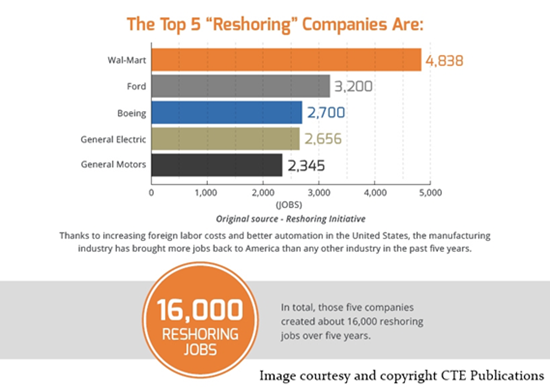Reshoring, Robots and What Happens if We Do Bring Jobs Back?
While offshoring is painted as the major villain in the decline of numbers of manufacturing jobs in the U.S., automation may actually be a bigger threat.
#automation
While auto manufacturing utilizes robots more than any other sector, industrial robots are also used in the manufacturing of metal products, plastics and chemicals. Without human operation, robots can weld, paint and package.
It is not just repetitive manufacturing jobs that are at risk. In a report issued last year, the McKinsey Global Institute predicted that currently demonstrated technologies could automate 45% of the activities people are paid to perform. Additionally, the report alleged that 30% of the activities in 60% of all occupations in the U.S. could be automated, just with the technologies available today. Whether or not jobs are automated, even if the technology is available, depends on many issues including the costs of automation vs. human labor, and whether or not standards could be met with automation.
An example for the valve industry could be in testing of valves. While it is possible that robots could perform the tests, would those results be accepted and trusted by standards committees and end users?
There is also research from The Chartered Institute of Ergonomics and Human Factors (CIEHF) in the U.K. that appears to show that, rather than taking jobs, robotics may leave humans with better jobs. Steve Barraclough, CEO of the CIEHF, said: “Robots and automation are regularly given a bad name. However, while automation might remove some mundane and repetitive jobs, it also makes a significant contribution to ‘upskilling’ employees, which is often overlooked.”
Barraclough pointed out that automation requires people to program and maintain the technology, which he says presents a real opportunity for businesses and manufacturers that are embracing change.
Whether there are enough of these jobs to offset the loss of unskilled jobs to technology is yet to be seen. Additionally, the workers who have lost those jobs do not necessarily have the knowledge or training to do this new kind of work, which means that retraining is required, or those new kinds of tasks will be taken by newcomers to the workforce.
With that uncertainty, the question then arises: Will the big push to bring jobs back to America from India, China, Bangladesh and Korea make a difference in the numbers of well-paying jobs, or will the ongoing, rapid advances in technology of all kinds negate advances made by reshoring efforts?
Reshoring has been happening in the U.S. for some time, as noted in previous articles in VALVE magazine, so the concept of bringing jobs back to America did not begin during the 2016 presidential race. Industry leaders have been working on this for some time. In fact, Cutting Tool Engineering (CTE) magazine recently released an infographic that demonstrated just five companies – Wal-Mart, Ford, Boeing, General Electric and General Motors have brought back more than 16,000 jobs in the last five years.
According to the Reshoring Initiative, there are many reasons besides rising emerging market wages for American manufacturers to consider reshoring. Lead time, higher product quality and consistency, freight costs, lower inventory levels and better responsiveness to changing customer demands are important factors to consider. Additionally, there are risks to intellectual property rights when offshoring.
Many manufacturers have already seen the benefits of proximity, especially since the U.S. is still the world’s largest consumer.
Also, per the CTE article, as automation and tools for engineering have improved, so too has the complexity of the manufacturing industry. And many specialty manufacturing jobs can’t be easily sent overseas. Improvements in automation technology and engineering tools have actually been major assets to the new American economy, as productivity of the U.S. manufacturing sector has increased.
Many companies in the manufacturing industry are making concerted efforts to bring jobs back into the United States. Often, these new manufacturing jobs and the latest tools for engineering require advanced education and highly technical skills that only American workers have to offer, which leads to the next issue.
Skilled Worker Shortage
Where are the workers going to come from? Analysts at Deloitte estimate that some two million manufacturing jobs will go unfilled in the next decade, and in a February meeting between President Trump and 24 CEOs from some of the largest manufacturers in the U.S., Andrew Liveris, CEO and Trump MFG Advisory Panel lead, told the assemblage: “We have a supply-side issue today.” The number one issue currently facing manufacturers is recruiting and retaining skilled and talented employees.
Without those skilled workers, bringing jobs back to the U.S. may be an exercise in futility.
Kate Kunkel is senior editor of VALVE Magazine.
RELATED CONTENT
-
Isolation Valves for High-solids Severe Service
Understanding suspended solids and their effect on equipment is critical in choosing isolation valves for slurry service.
-
Solenoid Valves: Direct Acting vs. Pilot-Operated
While presenting in a recent VMA Valve Basics 101 Course in Houston, I found myself in a familiar role: explaining solenoid valves (SOVs) to attendees. (I work with solenoids so much that one VMA member at that conference joked that I needed to be wearing an I Heart Solenoids t-shirt). During the hands-on “petting zoo” portion of the program, which involves smaller groups of attendees, one of the most frequently asked questions I get from people came up: What’s the difference between direct-acting and pilot-operated SOVs, and how do we make a choice?
-
Water Hammer
Water hammer is a shock wave transmitted through fluid contained in a piping system.












 Unloading large gate valve.jpg;maxWidth=214)